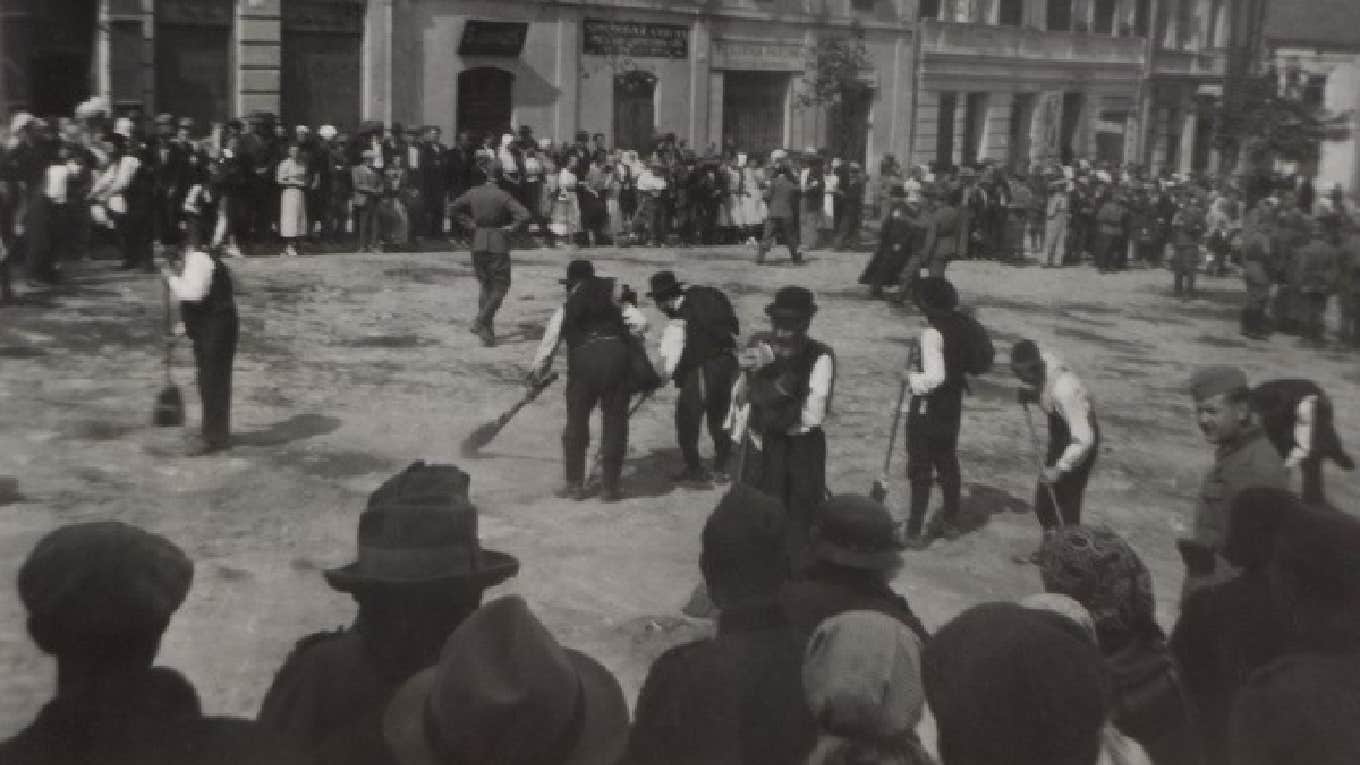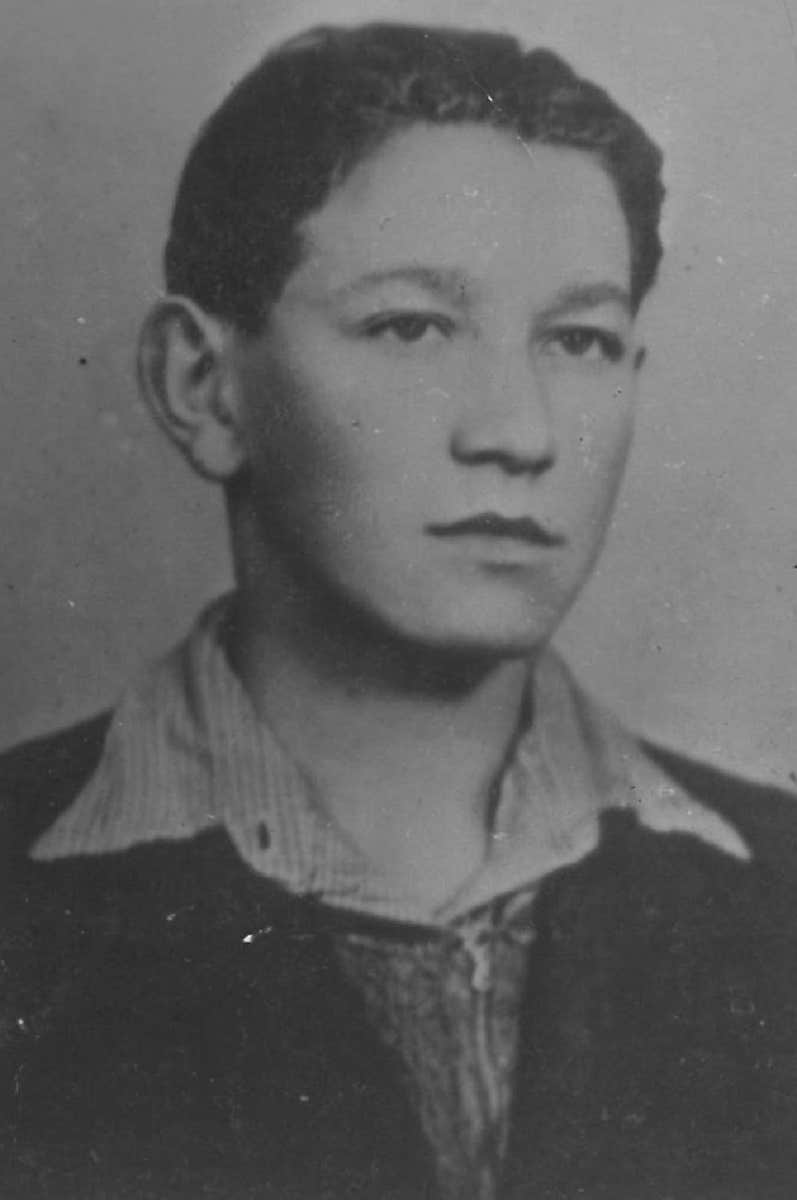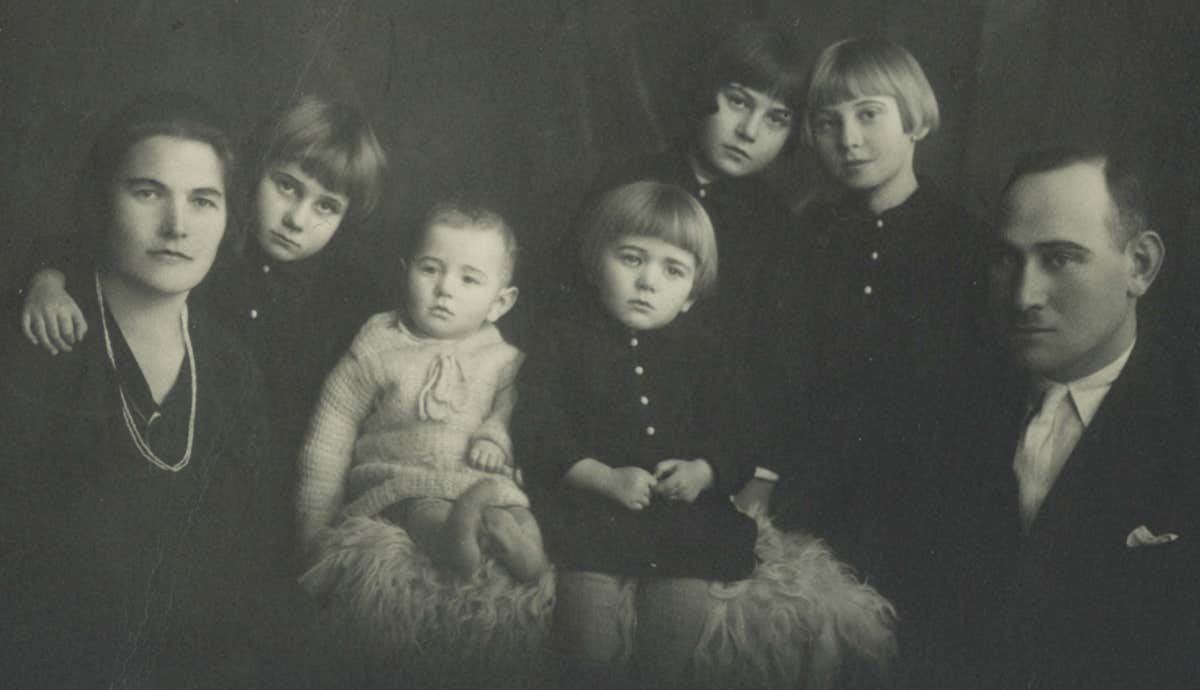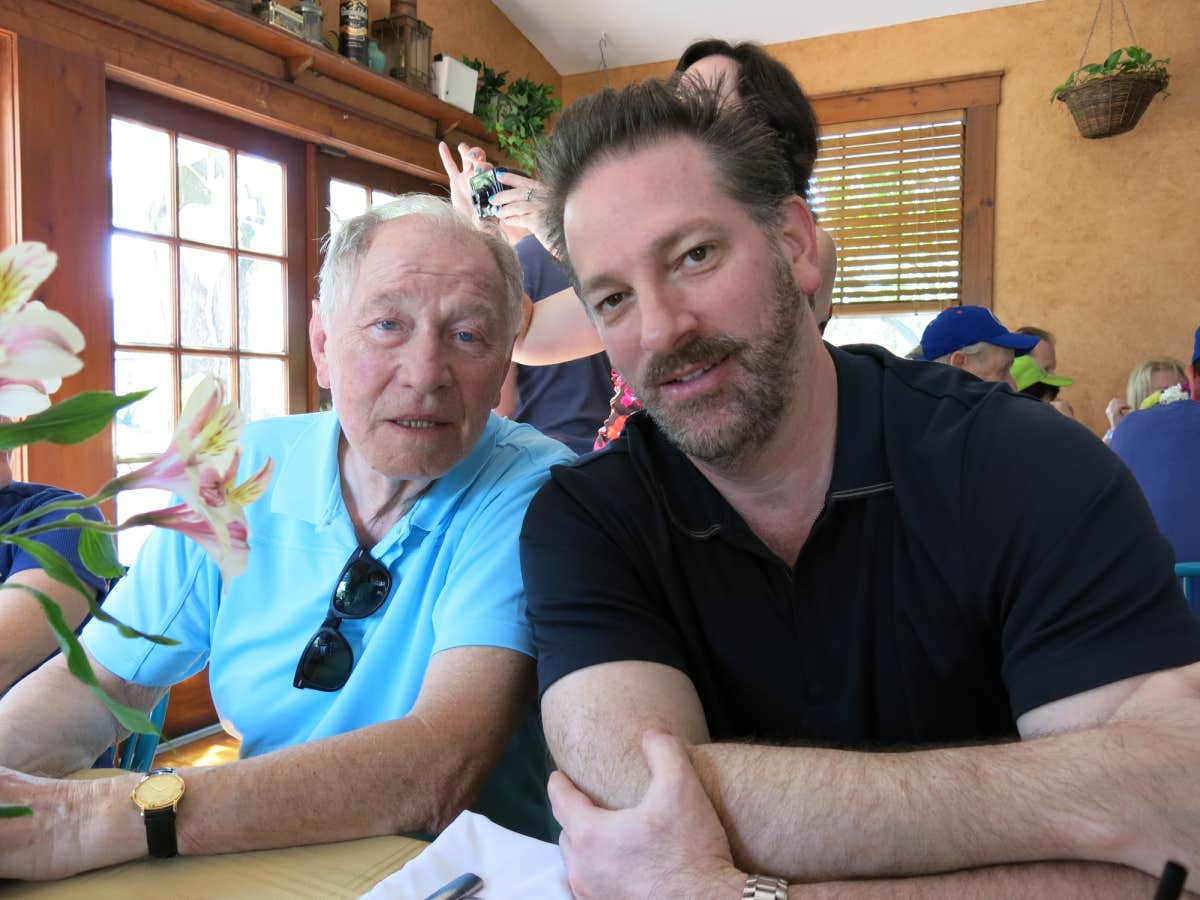Without My Father's Testimony, No One Would Know What Was Really Happening To The Men In This Photo
A misleading caption hides the critical truth only a Holocaust survivor's testimony could explain.
 Taken by unnamed Wehrmacht soldier on September 12, 1939; courtesy of Tomasz Wisniewski, Ph.D., Wisniewski Coll.
Taken by unnamed Wehrmacht soldier on September 12, 1939; courtesy of Tomasz Wisniewski, Ph.D., Wisniewski Coll. I first saw this photo on the walls of Yad Vashem, Israel's official memorial to the victims of the Holocaust, in June of 2022.
The image, which shows the round-up of Jewish men by Nazis in my father's town on September 12, 1939, is the most consequential photo in my book.
![Observant Wieliczka Jews forced to sweep the upper city square on September 12, 1939, as the Germans supervised. From here 32 Jewish men were put on lorries, driven to a nearby forest and shot by the Germans. [Photo taken by unnamed Wehrmacht soldier on September 12, 1939; courtesy of Tomasz Wisniewski, Ph.D., Wisniewski Coll. www.bagnowka. pl; and http://www.belzec.eu/media/files/pages/278/wieliczka_ang.pdf] Observant Wieliczka Jews forced to sweep the upper city square on September 12, 1939, as the Germans supervised. From here 32 Jewish men were put on lorries, driven to a nearby forest and shot by the Germans. [Photo taken by unnamed Wehrmacht soldier on September 12, 1939; courtesy of Tomasz Wisniewski, Ph.D., Wisniewski Coll. www.bagnowka. pl; and http://www.belzec.eu/media/files/pages/278/wieliczka_ang.pdf]](/sites/default/files/2022/the-round-up-of-sept-12-1939.png) Photo taken by unnamed Wehrmacht soldier on September 12, 1939 in Wieliczka, Poland; courtesy of Tomasz Wisniewski, Ph.D., Wisniewski Coll.
Photo taken by unnamed Wehrmacht soldier on September 12, 1939 in Wieliczka, Poland; courtesy of Tomasz Wisniewski, Ph.D., Wisniewski Coll.
Yad Vashem accepted my book, a memoir tracing the Holocaust through the eyes of my father, Nathan Poremba, who was nine years old on that day when his father was rounded up with those men and murdered by Nazis in southern Poland, into its library. But I didn't know this photo was on that wall when my book was published in 2021, and I did not see it there during my visit to the museum in 2018.
Seeing it now, the caption under it said "Jews in Forced Labor," which is terribly incorrect.
I write this not to focus on how Yad Vashem originally got the caption wrong (and still has it wrong), but rather, to focus on how important survivor testimony to such unspeakable events is.
The words of those who experienced this kind of horror not only provides the background to what one sees in a photo, but explains what one cannot see with the naked eye.
The importance of telling each Holocaust story fully and truthfully cannot be understated.
When it comes to the Shoah (the Hebrew word for the Holocaust), quite often what the eye sees in a photograph is but a small part of a much larger, different and darker story.
On September 12, 1939 the German army, along with the SS, a Polish municipal official, and Polish civilian neighbors, engaged in the round-up of thirty-two Jewish men in Wieliczka, Poland.
The photograph in question, taken by the Wehrmacht (the armed forces of the Third Reich) shows the start of that round-up.
What is not conveyed in the photograph taken by the Wehrmacht is what my father, Nathan Poremba, z”l (an abbreviation for the Hebrew phrase zichrono livracha, which means "of blessed memory"), witnessed as a child: the German strategy to guard against Jewish resistance, acting to slowly gain the complacence and passivity of the very people it targeted and intended to murder — in this case, Jewish Poles.
Black’s Law Dictionary defines a witness as “a person who has knowledge of an event. As the most direct mode of acquiring knowledge of an event is by seeing it, [the] ‘witness’ has acquired the sense of a person who is present at and observes a transaction.”
To explain the value of witness testimony, Elie Wiesel explained the role and importance of the eye-witness to the Shoah in a 2008 television series called All Things Considered:
“[O]ur stories are essential, essential to memory. I believe that the witnesses, especially the survivors [of the Shoah], have the most important role. They can simply say, in the words of the prophet, ‘I was there.’ ”
No one else can lay claim to this role but the person who was there, who saw and heard that which was laid before their eyes and ears.
My father Nathan witnessed, survived and provided testimony so the world would know what events preceded and followed this snapshot.
 Photo of Nathan Poremba in 1945 after the Holocaust, courtesy of the author
Photo of Nathan Poremba in 1945 after the Holocaust, courtesy of the author
All one can see in the photograph are the beginning stages of the round-up of 32 Jewish men and little else.
Yes, Jews being made to sweep a cobblestone road in the city’s main market square is what you think you see. But the viewer only sees this happening under the threat and with watchful eyes of the German Wehrmacht and my father’s Polish neighbors.
Far more, and far worse, is at play.
For six days prior, 9-year-old Nathan witnessed what the Germans were doing in Wieliczka.
The testimony he later shared as a survivor shed light on how Hitler's Final Solution functioned in the early stages of the war against the Jews, before this policy had been put on paper.
Without knowing what the Final Solution was — the mass murder of Europe’s Jews — Nathan witnessed the grand scheme of deception meant to foster the compliance of Nazi victims through trickery and false promises.
None of the Nazi-planned machinations of deception were yet known to the world, let alone the Jewish community of Wieliczka.
No one knew of the German strategy bent on fostering compliance and conditioning the Jews to being rounded up.
No one knew what might occur next after a round-up.
No one knew yet that they would typically be precursors to a mass genocide event.
“Jews in forced labor” — the caption used by Yad Vashem — is not an accurate description of what was happening in the photo, and it was certainly not what young Nathan witnessed.
What was really happening in the photo snapped by the German Wehrmacht on September 12th in Wieliczka, Poland on Rynek Górny Street
All one can observe in the photo are eight Orthodox Jewish Poles being made to sweep a cobblestone center square, hence the “Jews in forced labor” moniker that a museum might affix to this photo.
But this photo was taken minutes, maybe hours, before Nathan’s father, Joseph Poremba, z”l, was made to join the group at gunpoint.
Wieliczka’s last 32 Jewish men were then loaded up on trucks, driven to a nearby forest, lined up and murdered by machine gun.
This action was almost unheard of at the time, because few, if any, knew of planned mass killing events as early as September 1939.
Looking at the picture, I assume you, too, see only Jews sweeping a road.
But Nathan’s eye-witness testimony to the true events dispel any notion that the Jews standing there are "merely" being forced to do labor.
On September 7, 1939 Nathan was a nine-year old Jewish boy living in Wieliczka, Poland, a majority-Jewish small city just eight miles southeast of Kraków.
 Photo of the Poremba family in Wieliczka, Poland in 1932, courtesy of the author
Photo of the Poremba family in Wieliczka, Poland in 1932, courtesy of the author
The Wehrmacht rolled into Wieliczka on the 7th in personnel carrier trucks and on horseback. The city had already been nicknamed “a town without men,” for most Jewish men fled Wieliczka between September 1st and 6th.
But not all Jewish men ran away to hide upon the enemy’s arrival. Thirty-two refused to flee, one of which was Joseph Poremba.
Unbeknownst to the men who remained, from the 7th to the 11th, the Germans secretly worked with a Polish municipal clerk, Pawel Mazurowski, a voluntary accomplice, to create a kill-list of those remaining Jewish men who chose not to leave their families. It would take Mazurowski and the Wehrmacht five days to spy and compile this list of thirty-two Jewish men.
But how would the Germans round them up for mass murder without causing a panic or a rebellion?
On September 12th the Germans rounded-up Joseph and thirty-one other Jewish men without an uprising. The Germans were determined to have no resilience on this day which might have the unintended consequence of inspiring the Poles to question their own mortality and to rise up. The Germans could not risk resistance while establishing their dominance and control just twelve days into the war.
What the photograph fails to show is why the Germans met no resistance on this day. It was Nathan’s testimony as a survivor that provided the details one cannot see in the photo.
In order for the Germans to avoid a revolt, they had to demonstrate that their actions on the 12th (killing day) were no different than those of the five days that came before. The Germans conditioned Wieliczka’s Jews into thinking the September 12th round-up was merely another exercise in public humiliation, abuse and torture.
Over those five days, Nathan watched the Germans routinely round-up Jewish men and teenage boys and force them to sweep the roads in the market square, as seen in the photograph.
They forced the Jews to pick up horse dung with their bare hands and put it in their pockets and milk buckets, to push wheelbarrows laden with heavy boulders for transport from one end of Rynek Górny to the other for sport, and to do all of this while the Germans and Poles shouted humiliation and abuse at them.
The Poles came out to watch these events and to mock the targets of the German exercises.
Importantly, my father testified that nothing more than humiliation, the cutting of peiyot (sidelocks worn by Jewish men), and rough language was foisted on the Jewish men.
But once the secret kill-list was completed on September 12th, the Germans were led around town house-by-house by Nathan’s Polish neighbors to the location of the Jewish men.
The Germans proceeded into Nathan’s home and the homes of thirty-one other Jewish men and took them at gunpoint to the market square on Rynek Górny for a sixth consecutive day. From there, the men were loaded up onto trucks and told on this day they were being taken out of town for a different type of labor.
Suspecting nothing different was occurring than the five days that came before, no resistance was undertaken by the Jews. The Jewish men were taken two-and-a-half miles away to a nearby forest in Taszyce — where they were murdered.
The German plan to prevent resistance before it might occur was successful. They were able to conceal their murderous plan by making the day appear nearly identical to the previous five.
The daily exercises in humiliation, with nothing more, effectively sowed the seeds of passivity among Wieliczka’s Jewish population. Having believed nothing more would happen to them, the Jews did not resist and the German plan worked. There was no revolt.
Thus, the photo taken on September 12th captures only a small part of the story, and certainly is not correctly explained by merely describing it as “Jews in Forced Labor.”
The photo fails to show the viewer the larger picture of the German plan at work, something only a witness can do when he breathes life into this specific story.
It is Nathan’s eyewitness testimony that fills in the blanks and gives memory to the Jewish martyrs.
 Photo of the Nathan and Joel Poremba in 2014, courtesy of the author
Photo of the Nathan and Joel Poremba in 2014, courtesy of the author
So, what is the lesson from Nathan’s testimony as a survivor of terror as we watch current events unfold?
In a world that claims Jews did not resist, Nathan’s testimony explains the “why.”
The German’s psychological strategy in Wieliczka in a mere five days fostered inaction, allowing their Jewish victims to think no grave harm would come to them because nothing extreme had happened.
It was so early into the war there was simply no knowledge of what the Germans had planned. Only later did it become known what their motives were in conducting round-ups, public humiliation and abuse: a prelude to mass murder.
As the last Jew of Wieliczka, Nathan later testified and demonstrated to the world what it would not otherwise have not known about this photograph and what it says about the consequences of passivity in the face of psychological terror.
What the photo fails to show are the effects of and methods the Germans employed to suppress resistance.
But through testimony, one eyewitness was able to set the record straight in spite of the trauma inflicted on him by revisiting the scene of mass murder, including the murder of his own father.
May we all give thanks to survivors of terror who bear witness and testify so we all can learn and do better.
Joel Poremba is a business attorney with twenty-five years of litigation experience in both state and federal courts. The son of Holocaust survivor Nathan Poremba, he recently published the memoir of Nathan's story in "My Name is Staszek Surdel."
